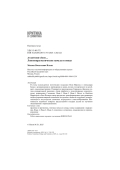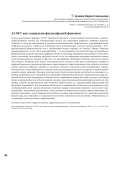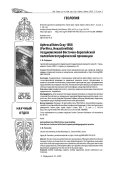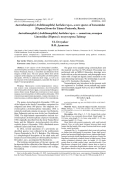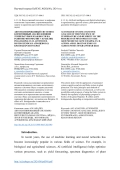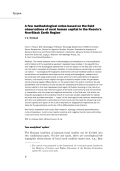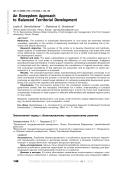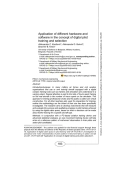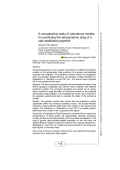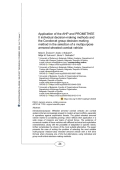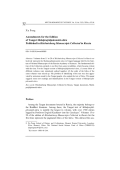В статье используются поэтические подсказки Поля Верлена и Александра Блока о возникновении и претворении в жизнь поэзии, человеческого и всеобщего самоосуществления. Развивается предложенная Терренсом Диконом логика универсальной эволюции. Автор прибегает к кумулятивному семиотическому разрешению Степанова: Язык-1, Язык-2, Язык-3. Вслед за Флойдом Мерреллом и Ежи Пельцем автор предлагает трансформировать трехуровневую модель формализованной семиотики дискретных знаков в непрерывно разворачивающиеся многообразия семиозиса непрерывного смыслообразования. Возможности подобного поворота предоставляют текущие усилия по изучению оязыковления и переязыковления.
Автор рассматривает феномен AI NPC (неигровой персонаж с искусственным интеллектом) в социально-философском аспекте, как потенциальную модель для построения цифрового двойника общества. Общество в статье рассматривается в реалиях посткоммуникации. Цифровизация, порождающая новую цифровую реальность, строится на замкнутом цикле коммуникации, согласно представлениям о постнеклассической рациональности или о «наблюдении второго порядка» по Никласу Луману. Общество трансформируется за счет цикла коммуникации — от исследования пользователей через метаданные до формирования моделей идеальных цифровых объектов, благодаря внедрению искусственного интеллекта нового поколения. Философская проблема состоит в том, что цифровыми моделями становятся сложные холистические объекты: человек и общество, что одновременно затрагивает проблему целостного идеального объекта. Возникает риск нового экзистенциального кризиса, когда при столкновении сознания и цифровой реальности происходит феномен отзеркаливания, потери возможности для субъекта различать степень ценности цифрового двойника и реального субъекта в межличностной коммуникации. Неигровой персонаж с искусственным интеллектом также рассматривается автором, как продукт стремительного развития рынка видеоигр. Массовая культура всегда была катализатором различных исследований, например, потребительского поведения и исследования общественных процессов. Видеоигры благодаря усиленной системе сбора метаданных становятся более совершенным миром массовой культуры, способным быстро подстраиваться под любое поведение человека, предоставляя вариативный виртуальный опыт. Как пример отдельно рассматривается кейс компании Replica Studios Inc., представившей виртуальный мир неигровых персонажей с искусственным интеллектом с применением технологии распознавания голоса и интерпретации речи. Данная симуляция совершила прорыв в индустрии видеоигр в части опыта взаимодействия с неигровыми персонажами. Автор отмечает положительные аспекты данного феномена. Неигровые персонажи с искусственным интеллектом способны демонстрировать на практике реализацию модели мира, как симуляции, и в перспективе могут быть повсеместно использованы в общественных исследованиях: социологических, маркетинговых.
Times of crises underscores the importance of guarding against deteriorations in the quality of loan portfolio through effective credit risk management. The purpose of the study is to examine the credit risk resilience of Namibia’s banking sector and forecast the quality of its loan portfolio. Methodologically, the study is hinged on the theories related to information asymmetry, moral hazard, and adverse selection. The methods include a VAR and an ARIMA out of sample dynamic forecasting model. The study employs secondary time-series data for the period 1996Q1–2021Q4 from various sources including the Bank of Namibia, the Namibia Statistics Agency, the World Bank and some others. The stress-testing results analysed via the VAR’s impulse responses show that Namibia’s banking sector is highly susceptible to various shocks with the early warnings emanating primarily from the non-performing loan itself, followed by the monetary, institutional, bank-specific, and interest rate indicators. The forecast for 2023Q4–2025Q4 obtained from the ARIMA model reveals that the riskiness of its loan portfolio is predicted to persist beyond the benchmark of 4 % set by the Bank of Namibia. The findings highlight important policy interventions, including the need to strengthen the mechanisms for monitoring the share of non-performing loans, re-evaluate existing policies, continue to ensure a sound macroeconomic and financial environment, and require banks to maintain a minimum capital adequacy ratio.
Позднемеловые и палеоценовые представители Aphrocallistes известны в Восточно-Европейской провинции по единичным элементам скелета. Фрагментарная сохранность фоссилий способствовала разноречивой характеристике рода и формированию представлений о многообразии этих губок. Колониальные Aphrocallistes рассматриваются как типичные представители маастрихтской спонгиофауны запада Европейской области.
Приведено иллюстрированное описание нового вида комаров-лимониид Austrolimnophila (Archilimnophila) barkalovi sp. n. с полуострова Таймыр по имаго обоих полов. Новый вид отличается от всех видов подрода Austrolimnophila (Archilimnophila) Alexander, 1934 относительно короткими крыльями, а также строением гипопигия самца, особенно формой тергита 9 и гонапофизов.
This article deals with the application of automated system-cognitive analysis and Eidos system in plant protection. The basic principles and methods of system-cognitive analysis are discussed, as well as the possibilities and prospects of using the Eidos system to identify the regularity of phytophagy progress in beetles of the genus Harpalus: H. affinis and H. distinguendus depending on temperature and humidity
The article presents some methodological considerations on the possibilities and limitations of the qualitative approach (repeated case studies in the specific Russian region) for the sociological assessment of human capital. In the first part of the article, the author considers the Russian tradition of rural studies as combining two analytical ‘optics’ - sociological/ethnographic observations of local realities based on various combinations of qualitative techniques and a strong anthropological/ peasant-studies emphasis with large-scale social surveys aimed at macro-descriptions of agrarian reforms, rural social/human capital and agro-industrial complex under the persistent trends of social-spatial differentiation. In the second part, the author mentions the key possibilities and limitations of case studies for assessing the state and prospects of rural human capital in the most depressed rural region of Russia, focusing on the role of entrepreneurs in formal and informal support of the local rural economy and communities in cooperation with municipal and regional authorities. In the final part, the author emphasizes typologies as the analytical result of rural case studies (especially the repeated ones) and provides examples - ‘types’ of the local agricultural producer relationships with the rural settlement’s authorities and community (as the basis for preserving rural human capital) and ‘types’ of the rural entrepreneurs’ biographical trajectories (as the basis for the generational continuity of this differentiated rural stratum).
Актуальность. Проблема сбалансированного и устойчивого развития сельских территорий чрезвычайно актуальна в настоящее время, особенно в условиях углубления локализации и возрастания роли природно-ресурсных факторов. Цель исследования. Целью статьи является разработка теоретико-методологических аспектов устойчивого развития территорий на основе экосистемного подхода для формирования единой многоуровневой стратегии их развития. Данные и методы. В статье обосновано применение экосистемного подхода к развитию сельских территорий с малыми городскими поселениями для повышения эффективности сельского бизнеса, оптимизации расходования бюджетных средств за счет приоритизации получателей государственной поддержки, стимулирования устойчивого развития предприятий и отрасли, повышения согласованности региональной экономической политики. Представлены концептуальные основы этого подхода и предложен алгоритм выбора участников сельской экосистемы. Результаты. Предложенный подход позволяет операционализировать процессы самоорганизации в экосистеме, обеспечить сбалансированность процессов взаимодействия ее участников. Результаты исследования вносят определенный вклад в решение проблемы формирования территориальной социально-экономической экосистемы посредством разработки алгоритма выбора целевых показателей достижения целей устойчивого развития с учетом специфики и тенденций развития территорий. Выводы. Выводы, вытекающие из проведенного исследования, предоставляют ученым и государственным органам необходимую информацию для лучшего понимания практических механизмов и инструментов обеспечения сбалансированного развития территорий, обеспечения перехода от фрагментарных бессистемных мер государственной поддержки к эффективной дифференцированной и адресной региональной политике.
Introduction/purpose: In many military air forces and civil aviation organizations that use or own training aircraft equipped with a digital cockpit, training tools such as trainers and simulators are understood to a varying extent. Special attention is paid to the ratio of hours spent training on the real aircraft to the number of hours spent on the simulator. This approach in training professional circles and the public is called Live virtual constructive. For all other teaching aids used for preparation for training, neither the methodology nor the extent of their use has been specifically investigated. The research aims to develop instruments that will measure and evaluate the success and qualitative progress in pilot training achieved by using the digital cabin space, based on which a decision can be made about further training for a specific aircraft type.
Methods: In conjunction with a PC-based aviation training device and advanced statistical analyses, an eye movement tracking device will help arrive at a reference pattern of instrument observation to train pilots and select pilot candidates.
Results: The proposed concept’s research includes detailed descriptions of the application of trainers and teaching aids with different profiles, which significantly impact the quality of the implementation of the digital cabin space in the training of cadet pilots.
Conclusion: Given that the Military Academy educates cadet pilots who continue their training in the operational flying units of the Serbian Armed Forces (SAF), it is essential that during the period spent at the Military Academy, their quality theoretical preparation be carried out.
Introduction/purpose: In this research, the influence of different turbulence models on the aerodynamic drag prediction of a generic spin-stabilized projectile was analyzed. The turbulence models chosen for investigation were one-equation Spalart-Allmaras, two-equation models Standard k-ε, Realizable k-ε, Standard k-ω and SST k-ω. The special sniper projectile M118 was selected for the study.
Methods: The flows around the projectile were numerically simulated using RANS equations intergrated into ANSYS Fluent software with different turbulence models. The numerical simulation was carried out at various Mach numbers to study the effect of turbulence models on the projectile aerodynamic drag prediction. The computational results were compared to the available experimental data to evaluate the ability of the turbulence models.
Results: The research results have shown that the turbulence models significantly affect the numerical simulation results. The Spalart-Allmaras turbulence model performs better than other models in the subsonic flow regime. The Standard k-ε, Realizable k-ε and SST k-ω models perform better than other models in the supersonic flow regime.
Conclusion: Computational Fluid Dynamics is a powerful tool to analyze the aerodynamics of flying bodies. By appropriately selecting turbulence models, the flow around flying bodies can be accurately investigated. In the case of generic ogive-cylinder-boattail projectiles, on the one hand, the Spalart-Allmaras model is suitable for subsonic flow, and the Standard k-ε, Realizable k-ε and SST k-ω models are recommended for the supersonic flight regime, on the other hand.
Introduction/purpose: Wheeled armored combat vehicles are combat systems that are increasingly present in modern armed conflicts, especially in operations against asymmetric threats. The global wheeled armored vehicle market is constantly growing, which reflects their application in a wide range of missions and tasks of armed forces. The existence of numerous models of these vehicles with different technical and exploitation characteristics, along with the possibility of adaptation to specific needs, further complicates the choice of the most suitable alternative. The paper presents the case of solving the problem of selecting the most suitable multi-purpose medium-class wheeled armored vehicle with a 4x4 drive formula when choosing one of the four alternatives, using individual and group multi-criteria decision-making methods.
Methods: In the paper, the methods of multi-criteria decision making were applied to solve problems in the field of complex combat systems selection. Experts from the field of tactics with weapon systems have ranked the alternatives following the defined criteria using the AHP (Analytic Hierarchy Process) and the PROMETHEE II (Preference Ranking Organization Method for Enrichment Evaluations II) methods. The results obtained by individual decision making were subjected to the Condorcet method of group decision making to make a final decision.
Result: Selection of the most suitable vehicle by the defined criteria.
Conclusion: Solving the problem involves taking into account the views of military experts regarding the optimization of multiple criteria to provide the best performance vehicle suitable for use in various missions. The choice of a multi-purpose wheeled armored combat vehicle is a complex process influenced by numerous factors that cannot be analyzed objectively without the application of adequate mathematical models.
Volumes from 15 to 20 of Heishuicheng Manuscripts Collected in Russia selectively represent the Mahāprajñāpāramitā-sūtra in Tangut language held by the Institute of Oriental Manuscripts of the Russian Academy of Sciences. The fundamental edition of the Collection certainly is not free from some invalidities, which became evident with the time. For the Tangut version of Mahāprajñāpāramitā-sūtra, (1) some folios of different volumes were mistakenly spliced together; (2) the order of the folios of the same volumes were mixed up. The problem of identifying of the text was also aggravated by omissions made by the Tangut people, who copied the text of Sūtra. This paper suggests some new readings and identifications in the Tangut version of Mahāprajñāpāramitā- sūtra.
